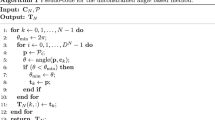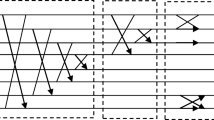Abstract
This work introduces the three-dimensional steerable discrete cosine transform (3D-SDCT), which is obtained from the relationship between the discrete cosine transform (DCT) and the graph Fourier transform of a signal on a path graph. One employs the fact that the basis vectors of the 3D-DCT constitute a possible eigenbasis for the Laplacian of the product of such graphs. The proposed transform employs a rotated version of the 3D-DCT basis. We then evaluate the applicability of the 3D-SDCT in the field of 3D medical image compression. We consider the case where we have only one pair of rotation angles per block, rotating all the 3D-DCT basis vectors by the same pair. The obtained results show that the 3D-SDCT can be efficiently used in the referred application scenario and it outperforms the classical 3D-DCT.




















Similar content being viewed by others
Notes
Such axes labels are used here with the purpose of distinguishing the coordinates in a three-dimensional (eigen)space only; we are not referring to axes x, y and z usually employed to characterize \(\mathbb {R}^3\).
Unless otherwise stated, from this point forward, the eigenvectors of \(\mathbf {L}(\mathcal {L}_N)\) are expressed as \(1\times N^3\) vectors, formed by the entries of the corresponding \(N\times N\times N\) structure taken in the lexicographical order.
The indexes are the same ones we have used to identify the eigenvalues and eigenvectors of \(\mathbf {L}(\mathcal {L}_N)\).
A practical rule for obtaining the other two coefficients of a triple, from a coefficient \(F_{k,l,m}\) lying in the red part of the cubical structures we have considered, is to apply two sequential cyclic shifts to the left to indexes k, l, m; in this manner, one obtains coefficients \(F_{l,m,k}\) and \(F_{m,k,l}\).
References
Ahmadzai, F., Rao, K. M. L., & Ulfat, S. (2019). Assessment and modelling of urban road networks using integrated graph of natural road network (a GIS-based approach). Journal of Urban Management, 8(1), 109–125.
Atal, D. K., & Singh, M. (2020). A hybrid feature extraction and machine learning approaches for epileptic seizure detection. Multidimensional Systems and Signal Processing, 31, 503–525.
Barboriak, D. (2015). Data from RIDER NEURO MRI.https://doi.org/10.7937/K9/TCIA.2015.VOSN3HN1.
Beferull-Lozano, B., Xie, H. & Ortega, A. (2003). Rotation-invariant features based on steerable transforms with an application to distributed image classification. In 2003 International Conference on Image Processing, 3, III–521.
Bjøntegaard, G. (2001). Calculation of average PSNR differences between RD-curves. ITU-T VCEG-M33.
Bondy, J. A., & Murty, U. S. R. (1976). Graph theory with applications. New York: Elsevier.
Brieva, J., Moya-Albor, E., Gomez-Coronel, S.L. & Ponce, H. (2017). Video motion magnification for monitoring of vital signals using a perceptual model. In 12th International Symposium on Medical Information Processing and Analysis (SPIE), 10160, (pp. 156–167).
Carvalho, M.B., Pereira, M.P., Alves, G., Silva, E.A.B., Pagliari, C.L., Pereira, F. & Testoni, V. (2018). A 4D-DCT-based lenslet light field codec. In 2018 25th IEEE International Conference on Image Processing (ICIP) (pp. 435–439).
Chakraborty, A., Dutta, T., Mondal, S., & Nath, A. (2018). Application of graph theory in social media. International Journal of Computer Sciences and Engineering, 6, 722–729.
Chung, F. R. K. (1997). Spectral graph theory. Providence, RI: American Mathematical Society.
Clark, K., Vendt, B., Smith, K., Freymann, J., Kirby, J., Koppel, P., et al. (2013). The cancer imaging archive (TCIA): Maintaining and operating a public information repository. Journal of Digital Imaging, 26(6), 1045–1057.
Conti, C., Soares, L. D., & Nunes, P. (2016). HEVC-based 3D holoscopic video coding using self-similarity compensated prediction. Signal Processing: Image Communication, 42, 59–78.
Conti, C., Nunes, P., & Soares, L. D. (2018). Light field image coding with jointly estimated self-similarity bi-prediction. Signal Processing: Image Communication, 60, 144–159.
Deri, J. A. & Moura, J. M. F. (2016). New York city taxi analysis with graph signal processing. In 2016 IEEE Global Conference on Signal and Information Processing (GlobalSIP) (pp. 1275–1279).
Diestel, R. (1997). Graph theory. No. 173 in graduate texts in mathematics. New York: Springer.
Escalante-Ramírez, B. (2008). The Hermite transform as an efficient model for local image analysis: An application to medical image fusion. Computers & Electrical Engineering, 34(2), 99–110.
Estudillo-Romero, A., & Escalante-Ramirez, B. (2011). Rotation-invariant texture features from the steered Hermite transform. Pattern Recognition Letters, 32(16), 2150–2162.
Farahani, F. V., Karwowski, W., & Lighthall, N. R. (2019). Application of graph theory for identifying connectivity patterns in human brain networks: A systematic review. Frontiers in Neuroscience, 13, 1–27.
Fracastoro, G., & Magli, E. (2017). Steerable discrete Fourier transform. IEEE Signal Processing Letters, 24(3), 319–323.
Fracastoro, G., Fosson, S. M., & Magli, E. (2017). Steerable discrete cosine transform. IEEE Transactions on Image Processing, 26(1), 303–314.
Grando, F., Noble, D. & Lamb, L.C. (2016). An analysis of centrality measures for complex and social networks. In IEEE Global Communications Conference, GLOBECOM, NA, (pp 1–6).
Hackl, J., & Adey, B. T. (2019). Estimation of traffic flow changes using networks in networks approaches. Applied Network Science, 4(28), 1–26.
Horn, R. A., & Johnson, C. R. (1991). Topics in matrix analysis. New York: Cambridge University Press.
Hu, W., Cheung, G., Ortega, A., & Au, O. C. (2015). Multiresolution graph Fourier transform for compression of piecewise smooth images. IEEE Transactions on Image Processing, 24(1), 419–433.
Huang, X., Zhao, Y., Ma, C., Yang, J., Ye, X., & Zhang, C. (2016). TrajGraph: A graph-based visual analytics approach to studying urban network centralities using taxi trajectory data. IEEE Transactions on Visualization and Computer Graphics, 22(1), 160–169.
Jansen, S., & Terry, V. D. (2015). TCIA mouse-astrocytoma collection. https://doi.org/10.7937/K9TCIA.2017.SGW7CAQW
Jansen, S., Ileva, L., Lu, L., & Terry, V. D. (2015). TCIA mouse-mammary collection. https://doi.org/10.7937/K9/TCIA.2015.9P42KSE6.
Kandhway, P., & Bhandari, A. K. (2019). An optimal adaptive thresholding based sub-histogram equalization for brightness preserving image contrast enhancement. Multidimensional Systems and Signal Processing, 30(4), 1859–1894.
Kim, Y.K., He, Z. & Mitra, S.K. (2001). A novel linear source model and a unified rate control algorithm for H.263/MPEG-2/MPEG-4. In 2001 IEEE International Conference on Acoustics, Speech, and Signal Processing. Proceedings, 3, (pp. 1777–1780).
Le Pennec, E., & Mallat, S. (2005). Sparse geometric image representations with bandelets. IEEE Transactions on Image Processing, 14(4), 423–438.
Lee, M. C., Chan, R. K. W., & Adjeroh, D. A. (1997). Quantization of 3D-DCT coefficients and scan order for video compression. Journal of Visual Communication and Image Representation, 8(4), 405–422.
Li, X., Abramson, R. G., Arlinghaus, L. R., Chakravarthy, A. B., Abramson, V. G., Sanders, M., et al. (2015). Multiparametric magnetic resonance imaging for predicting pathological response after the first cycle of neoadjuvant chemotherapy in breast cancer. Investigative Radiology, 50(4), 195–204.
Li, X., Abramson, R. G., Arlinghaus, L. R., Chakravarthy, A. B., Abramson, V. G., Sanders, M., et al. (2016). TCIA data from QIN-breast.,. https://doi.org/10.7937/K9/TCIA.2016.21JUebH0.
Litjens, G., Debats, O., Barentsz, J., Karssemeijer, N., & Huisman, H. (2014). Computer-aided detection of prostate cancer in MRI. IEEE Transactions on Medical Imaging, 33(5), 1083–1092.
Litjens, G., Debats, O., Barentsz, J., Karssemeijer, N., & Huisman, H. (2017). ProstateX challenge data. https://doi.org/10.7937/K9TCIA.2017.MURS5CL.
Liu, D., An, P., Ma, R., Yang, C., & Shen, L. (2016). 3D holoscopic image coding scheme using HEVC with Gaussian process regression. Signal Processing: Image Communication, 47, 438–451.
Lucchesi, F.R. & Aredes, N.D. (2016). Radiology data from the cancer genome atlas cervical squamous cell carcinoma and endocervical adenocarcinoma [TCGA-CESC] collection. https://doi.org/10.7937/K9/TCIA.2016.SQ4M8YP4.
Ma, F., Yao, B. & Yao, M. (2016). Non-planar unclustered peterson graphs as scale-free models of the internet of things. In 2016 IEEE Information Technology, Networking, Electronic and Automation Control Conference (pp. 1040–1043).
Merri, R. (1998). Laplacian graph eigenvectors. Linear Algebra and its Applications, 278(1), 221–236.
Mohan, D.M., Asif, M.T., Mitrovic, N., Dauwels, J. & Jaillet, P. (2014). Wavelets on graphs with application to transportation networks. In: 17th International IEEE Conference on Intelligent Transportation Systems (ITSC) (pp. 1707–1712).
Moya-Albor, E., Escalante-Ramirez, B., & Vallejo, E. (2013). Optical flow estimation in cardiac CT images using the steered Hermite transform. Signal Processing: Image Communication, 28(3), 267–291.
Moya-Albor, E., Mira, C., Brieva, J., Escalante-Ramirez, B. & Venegas, E. (2017). 3D optical flow estimation in cardiac CT images using the Hermite transform. In 12th Symposium on Medical Information Processing and Analysis, 10160 (pp. 288–298).
Ortega, A., Frossard, P., Kovacevic, J., Moura, J. M. F., & Vandergheynst, P. (2018). Graph signal processing: Overview, challenges, and applications. Proceedings of the IEEE, 106(5), 808–828.
Pereira, F.S.F., Amo, S. & Gama, J. (2016). Evolving centralities in temporal graphs: A twitter network analysis. In IEEE 17th International Conference on Mobile Data Management, MDM (pp. 43–48).
Rubinov, M., & Sporns, O. (2010). Complex network measures of brain connectivity: Uses and interpretations. NeuroImage, 52(3), 1059–1069.
Salomon, D., & Motta, G. (2009). Handbook of data compression (5th ed.). New York: Springer.
Sandryhaila, A., & Moura, J. M. F. (2014). Discrete signal processing on graphs: Frequency analysis. IEEE Transactions on Signal Processing, 62(12), 3042–3054.
Santos, J. M., Assuncao, P. A. A., Cruz, L. A. S., Távora, L. M. N., Fonseca-Pinto, R., & Faria, S. M. M. (2018). Lossless coding of light field images based on minimum-rate predictors. Journal of Visual Communication and Image Representation, 54, 21–30.
Sardellitti, S., Barbarossa, S., & Di Lorenzo, P. (2017). On the graph Fourier transform for directed graphs. IEEE Journal of Selected Topics in Signal Processing, 11(6), 796–811.
Shoham, Y., & Gersho, A. (1988). Efficient bit allocation for an arbitrary set of quantizers (speech coding). IEEE Transactions on Acoustics, Speech, and Signal Processing, 36(9), 1445–1453.
Shuman, D. I., Faraji, M. J., & Vandergheynst, P. (2016). A multiscale pyramid transform for graph signals. IEEE Transactions on Signal Processing, 64(8), 2119–2134.
Shuman, D. I., Narang, S. K., Frossard, P., Ortega, A., & Vandergheynst, P. (2013). The emerging field of signal processing on graphs: Extending high-dimensional data analysis to networks and other irregular domains. IEEE Signal Processing Magazine, 30(3), 83–98.
Shuman, D.I., Ricaud, B. & Vandergheynst, P. (2012). A windowed graph Fourier transform. In IEEE Statistical Signal Processing Workshop (SSP) (pp. 133–136).
Sporns, O. (2018). Graph theory methods: Applications in brain networks. Dialogues in Clinical Neuroscience, 20(2), 111–121.
Steeb, W. H. H. (1997). Matrix calculus and the kronecker product with applications and C++ Programs. USA: World Scientific Publishing Co. Inc.
Strang, G. (1999). The discrete cosine transform. SIAM Review, 41(1), 135–147.
Vallières, M., Freeman, C. R., Skamene, S. R., & El Naqa, I. (2015). A radiomics model from joint FDG-PET and MRI texture features for the prediction of lung metastases in soft-tissue sarcomas of the extremities. Physics in Medicine & Biology, 60(14), 5471–5496.
van Djik, A. M., & Martens, J. B. (1997). Image representation and compression with steered Hermite transforms. Signal Processing, 56(1), 1–16.
Vargas-Quintero, L., Escalante-Ramírez, B., Marín, L. C., Huerta, M. G., Cosio, F. A., & Olivares, H. B. (2016). Left ventricle segmentation in fetal echocardiography using a multi-texture active appearance model based on the steered Hermite transform. Computer Methods and Programs in Biomedicine, 137, 231–245.
Wang, Z., Bovik, A. C., Sheikh, H. R., & Simoncelli, E. P. (2004). Image quality assessment: From error visibility to structural similarity. IEEE Transactions on Image Processing, 13(4), 600–612.
Zhang, J., & Moura, J. M. F. (2014). Diffusion in social networks as SIS epidemics: Beyond full mixing and complete graphs. IEEE Journal of Selected Topics in Signal Processing, 8(4), 537–551.
Acknowledgements
This work was supported by CNPq under Grants 309598/2017-6 and 409543/2018-7.
Author information
Authors and Affiliations
Corresponding author
Additional information
Publisher's Note
Springer Nature remains neutral with regard to jurisdictional claims in published maps and institutional affiliations.
Rights and permissions
About this article
Cite this article
Lima, V.S., Madeiro, F. & Lima, J.B. Three-dimensional steerable discrete cosine transform with application to 3D image compression. Multidim Syst Sign Process 32, 491–519 (2021). https://doi.org/10.1007/s11045-020-00746-9
Received:
Revised:
Accepted:
Published:
Issue Date:
DOI: https://doi.org/10.1007/s11045-020-00746-9




